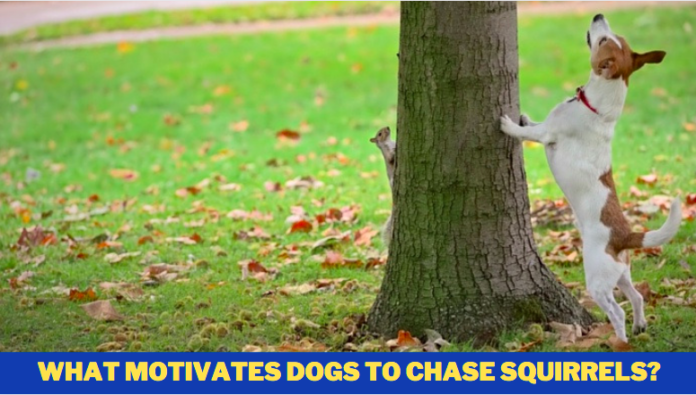What motivates Dogs to Chase Squirrels?
Once again, your dog is chasing another creature in your backyard. While their preferred little creatures maybe squirrels, your dog is not selective.
They chase anything they see, whether it’s a bunny, raccoon, possum, or anything else.
Why is it that your dog pursues squirrels and other small hairy creatures?
While the behaviour has been mostly benign thus far, you’re concerned that the chase may result in your dog becoming loose and subsequently lost — or, worse, being bitten by the other animal. If you’ve been wondering why your dog enjoys squirrel hunting, this guide will explain why the habit occurs and whether you can stop it.
What Motivates Dogs to Pursue Squirrels?
There are a variety of reasons why your dog would chase small animals such as raccoons, porcupines, skunks, and chipmunks, but the most prevalent are curiosity, playfulness, and predatory drive.
Curiosity or a sense of humour

A young puppy, for example, maybe intrigued by fast-moving critters and chase after them to find out what they’re doing, or to join in and “play” with them. This natural curiosity is wonderful, but it’s important to keep a close eye on your pet while outdoors. You don’t want them to wander away while chasing prey, and you wouldn’t want them to be bitten by a small animal either!
Predatory Drive
If not for curiosity, why do dogs chase squirrels? While some dogs may just want to play with a squirrel, there are others who see a critter as their prey, and their predatory drive kicks in.
Dogs who are predatory chasers are attempting to catch their prey — and eat or extinguish it. You’ll want to make sure a dog with a predatory drive is also watched afterwards so that they don’t run far away (and so you don’t get “greeted” regularly with a mouthful of a squirrel).
On the other hand, there’s no need for concern if your dog doesn’t seem interested in chasing squirrels or other small animals. They simply may not have the impulse.
However, if your dog was once extremely driven to chase prey, yet suddenly shows no interest, it may be a smart idea to check in with their veterinarian. Any sudden changes in behaviour may be indicative that something is wrong.
Which Breeds Are the Biggest Chasers?
According to the American Kennel Club (AKC), sighthounds of all sizes, such as Afghan hounds and Whippets, were bred to chase. Other breeds, specifically herding dogs such as border collies and German shepherds, are also inherently prone to chasing, due to their drive to corral animals.

However, this does not exclude a different breed from being motivated to chase. Any dog that notices a small animal scurrying across its territory may become intrigued. This fascination has the potential to turn into a “game” or a hunt for prey!
Can Dogs Be Taught to Avoid Chasing?
Additionally, the AKC notes that “the drive to chase is natural in many dogs and is a highly self-rewarding activity, but because some dogs like it so much, training them not to do it can be especially difficult.” That is not to say, however, that all hope is lost. You can teach your pet not to chase, most effectively while they are puppies, but also with some difficulty later in life.
Leash training and rewarding your pet with toys and treats during outside training opportunities are critical in teaching them to listen to you and avoid their natural desire to chase.
Dog impulse training can be challenging because you are teaching them to disregard an innate urge, but by redirecting that innate desire to a more productive activity, you can fuel your dog’s desire to chase in a safer manner.
How to Keep Chasing Dogs Safe
While you’re learning to train your dog to avoid chasing small animals, here are a few tips to keep them safe:
- Always keep them on a leash when walking them in public: If they tend to have a mind of their own, keep a short leash to avoid them being able to get a running start and potentially harming themselves or pulling you down.
- Using a harness to attach your leash to Harnesses are great because they don’t put pressure on your dog’s neck and throat if they pull. It wraps around more of their body to also give you more control in redirecting their attention.
- Block all exits routes: While it may be hard to keep squirrels and other small critters out of your backyard, make sure that if you let your dog out to run around on their own that there aren’t any potential breaks in the fence or places they could easily jump over.
- Keep a watchful eye: While most small critters aren’t known for fighting back when they feel threatened, they react. Pay close attention to your dog’s behaviours after letting them out.Any sign of behaviour changes that could indicate that they were attacked, is important to catch quickly. Any signs of bites, scratches or other indications that your dog was attacked are worth calling your veterinarian immediately and getting their consult.
As long as you keep your dog safe, by not allowing them to get loose during a chase and training them well, you can rest assured that chasing is normal behaviour for your dog.
Fact-Finding:
Thanks for reading and have a great day! What motivates Dogs to Chase Squirrels?
Please post your thoughts in the comments section if you have any. Please feel free to share!













